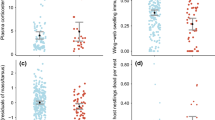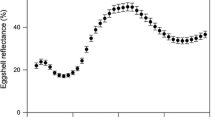Abstract
Despite their importance to offspring fitness outcomes, there has been little previous work on egg-mediated maternal effects in avian brood parasites which lay their eggs in the nests of other species. Here, we examine patterns of egg yolk antioxidant deposition in an avian host (red-winged blackbird, Agelaius phoeniceus) and their brood parasite (brown-headed cowbird, Molothrus ater). Cowbird nestlings compete directly for food with host blackbird chicks and succeed, despite hatching from a smaller egg, by begging more intensely and growing as or more rapidly than their hosts. Dietary-derived antioxidants, such as carotenoids and vitamins E and A, deposited in egg yolk, may enhance growth rate and reduce oxidative stress, and therefore provide a potential mechanism by which female cowbirds could enhance the competitiveness of their young in host nests. However, provision of antioxidants to eggs is costly so we predicted that female cowbirds should adjust the amount of antioxidants in response to variation in host quality. We found that whilst red-winged blackbird clutches parasitised by cowbirds did not differ in the pattern of antioxidant deposition compared to non-parasitised clutches, levels of vitamin E deposited in cowbird eggs were closely matched to that of the individual host clutch in which cowbirds laid their egg. This supports the prediction that female cowbirds adjust the antioxidant concentration of their eggs to increase the likely competitiveness of their offspring in the host nest into which they are laid and may help explain the success of cowbirds in competing with larger host young.




Similar content being viewed by others
References
Badyaev AV, Uller T (2009) Parental effects in ecology and evolution: mechanisms, processes and implications. Phil Trans R Soc B 364:1169–1177
Blount JD, Houston DC, Møller AP (2000) Why egg yolk is yellow. Trends Ecol Evol 15:47–49
Blount JD, Surai PF, Houston DC, Møller AP (2002) Patterns of yolk enrichment with dietary carotenoids in gulls: the roles of pigment acquisition and utilization. Func Ecol 16:445–453
Blount JD, Metcalfe NB, Arnold KE, Surai PF, Devevey GL, Monaghan P (2003) Neonatal nutrition, adult antioxidant defences and sexual attractiveness in the zebra finch. Proc R Soc B 270:1691–1696
Blount JD, Houston DC, Surai PF, Møller AP (2004) Egg-laying capacity is limited by carotenoid pigment availability in wild gulls Larus fuscus. Proc R Soc B (suppl) 271:S79–S81
Catoni C, Peters A, Schaefer M (2008) Life history trade-offs are influenced by the diversity, availability and interactions of dietary antioxidants. Anim Behav 76:1107–1119
Chew BP, Park JS (2004) Carotenoid action on the immune response. J Nutr 134:257S–262S
Clotfelter ED (1998) What cues do brown-headed cowbirds use to locate red-winged blackbird nests? Anim Behav 55:1181–1189
Crawley MJ (2002) Statistical computing: an introduction to data analysis using S-Plus. Wiley, Chichester
Cucco M, Guasco B, Malacarne G, Ottonelli R (2006) Effects of β-carotene supplementation on chick growth, immune status and behaviour in the grey partridge, Perdix perdix. Behav Processes 73:325–332
Davies NB (2000) Cuckoos, cowbirds and other cheats. T & AD Poyser, London
De Ayala RM, Martinelli R, Saino N (2006) Vitamin E supplementation enhances growth and condition of nestling barn swallows (Hirundo rustica). Behav Ecol Sociobiol 60:619–630
Forbes S, Glassey B, Thornton S, Earle L (2001) The secondary adjustment of clutch size in red-winged blackbirds (Agelaius phoeniceus). Behav Ecol Sociobiol 50:37–44
Glassey B, Forbes S (2003) Why brown-headed cowbirds do not influence red-winged blackbird parent behaviour. Anim Behav 65:1235–1246
Grant ND, Sealy SG (2002) Selection of red-winged blackbird (Agelaius phoeniceus) hosts by the brown-headed cowbird (Molothrus ater). Bird Behav 15:21–30
Grau CR (1976) Ring structure of avian egg yolk. Poult Sci 55:1418–1422
Hahn DC, Hatfield JS, Abdelnabi MA, Wu JM, Igl LD, Ottinger MA (2005) Inter-species variation in yolk steroid levels and a cowbird-host comparison. J Avian Biol 36:40–46
Hall ME, Blount JD, Forbes S, Royle NJ (2010) Does oxidative stress mediate the trade-off between growth and self-maintenance in structured families? Func Ecol 24:365–373
Hargitai R, Moskát C, Bán M, Gil D, López-Rull I, Solymos E (2010) Eggshell characteristics and yolk composition in the common cuckoo Cuculus canorus: are they adapted to brood parasitism? J Avian Biol 41:177–185
Hauber ME, Pilz KM (2003) Yolk testosterone levels are not consistently higher in the eggs of obligate brood parasites than their hosts. Am Mid Nat 149:354–362
Hauber ME, Yeh PJ, Roberts JOL (2004) Patterns and coevolutionary consequences of repeated brood parasitism. Proc R Soc B (suppl) 271:5317–5320
Helfenstein F, Berthouly A, Tanner M, Karadas F, Richner H (2008) Nestling begging intensity and parental effort in relation to prelaying carotenoid availability. Behav Ecol 19:108–115
Hinde CA, Buchanan KL, Kilner RM (2009) Prenatal environmental effects match offspring begging to parental provisioning. Proc R Soc B 276:2787–2794
Hoover JP, Robinson SK (2007) Retaliatory mafia behavior by a parasitic cowbird favors host acceptance of parasitic egg. Proc Natl Acad Sci USA 104:4479–4483
Hoyt DF (1979) Practical methods of estimating volume and fresh egg weight of bird eggs. Auk 96:73–77
Kattan GH (1995) Mechanisms of short incubation period in brood-parasitic cowbirds. Auk 112:335–342
Kilner RM, Madden JR, Hauber ME (2004) Brood parasitic cowbird nestlings use host young to procure resources. Science 305:877–879
Kilpatrick AM (2002) Variation in growth of brown-headed cowbird (Molothrus ater) nestlings and energetic impacts on their host parents. Can J Zool 80:145–153
Klasing KC (1998) Comparative avian nutrition. CAB International
Kruger O (2007) Cuckoos, cowbirds and hosts: adaptations, trade-offs and constraints. Phil Trans R Soc B 362:1873–1886
Lessells CM, Boag PT (1987) Unrepeatable repeatabilities: a common mistake. Auk 104:116–121
Lichtenstein G, Sealy SG (1998) Nestling competition, rather than supernormal stimulus, explains the success of parasitic brown-headed cowbird chicks in yellow warbler nests. Proc R Soc Lond B 265:249–254
McMaster DG, Sealy SG (1998) Short incubation periods of brown-headed cowbirds: how do cowbird eggs hatch before yellow warbler eggs? Condor 100:102–111
Moreno J, Osorno JL (2003) Avian egg colour and sexual selection: does eggshell pigmentation reflect female condition and genetic quality? Ecol Letts 6:803–806
Mousseau TA, Fox CW (1998) Maternal effects as adaptations. Oxford University Press, New York
Newbrey JL, Reed WL, Foster SP, Zander GL (2008) Laying-sequence variation in yolk carotenoid concentrations in eggs of yellow-headed blackbirds (Xanthocephalus xanthocephalus). Auk 125:124–130
O’Brien EL, Dawson RD (2008) Parasite-mediated growth patterns and nutritional constraints in a cavity-nesting bird. J Anim Ecol 77:127–134
Olson VA, Owens IPF (1998) Costly sexual signals: are carotenoids rare, risky or required? Trends Ecol Evol 13:510–514
Ortega CP, Cruz A (1988) Mechanisms of egg acceptance in marsh dwelling blackbirds. Condor 90:349–359
Ortega CP, Cruz A (1991) A comparative study of cowbird parasitism in yellow-headed blackbirds and red-winged blackbirds. Auk 108:16–24
Røskaft E, Orians GH, Beletsky LD (1990) Why do red-winged blackbirds accept eggs of brown-headed cowbirds? Evol Ecol 4:35–42
Rothstein S (1975) Evolutionary rates and host defences against avian brood parasitism. Am Nat 109:161–176
Royle NJ, Surai PF, Hartley IR (2001) Maternally derived androgens and antioxidants in bird eggs: complementary but opposing effects? Behav Ecol 12:381–385
Royle NJ, Surai PF, Hartley IR (2003) The effect of variation in dietary intake on maternal deposition of antioxidants in zebra finch eggs. Func Ecol 17:472–481
Schwabl H (1996) Maternal testosterone in the avian egg enhances postnatal growth. Comp Biochem Physiol A 114:271–276
Scott KJ (2001) Unit F2.2 detection and measurement of carotenoids by UV/VIS spectrophotometry In: Wrolstad RE (ed) Current Protocols in Food Analytical Chemistry. Wiley, Chichester
Scott DM, Ankney CD (1983) The laying cycle of brown-headed cowbirds: passerine chickens? Auk 100:583–592
Sherry DF, Forbes MRL, Khurgel M, Ivy GO (1993) Females have a larger hippocampus than males in the brood-parasitic brown-headed cowbird. Proc Natl Acad Sci USA 90:7839–7843
Smith JMN, Arcese P, McLean IG (1984) Age, experience, and enemy recognition by wild song sparrows. Behav Ecol Sociobiol 14:101–106
Starck JM, Ricklefs RE (1998) Table 17.2 Avian growth parameters. In: Starck JM, Ricklefs RE (eds) Avian growth and development: evolution within the altricial–precocial spectrum. Oxford University Press, Oxford, p 412
Surai PF (2002) Natural antioxidants in avian health and nutrition. Nottingham University Press, Nottingham
Torok J, Moskat C, Michl G, Peczely P (2004) Common cuckoos (Cuculus canorus) lay eggs with larger yolk but not more testosterone than their great reed warbler (Acrocephalus arundinaceus) hosts. Ethol Ecol Evol 16:271–277
Weatherhead PJ (1989) Sex ratios, host-specific reproductive success, and impact of brown-headed cowbirds. Auk 106:358–366
Woolfenden BE, Gibbs HL, Sealy SG, McMaster DG (2003) Host use and fecundity of individual female brown-headed cowbirds. Anim Behav 66:95–106
Acknowledgments
We would like to thank the following people for their assistance in the field: in 2007 Jessie Cameron, Meghan Chatwin, Jodi Griffiths, Laura Groening, Miriam Knolly, Carrie Ross, and Aaron Trachtenberg, and in 2008, Joana Agudo, Meghan Chatwin, Leanne Grieves, Joana Nunes, and James Rogers. Thanks also to Sam Weber for advice and help with laboratory protocols, and to two anonymous reviewers who provided constructive comments on a previous version of this paper. Our field methodology received prior approval from the Senate Animal Care Committee (SACC) of the University of Winnipeg. This research was funded by a NERC New Investigator grant to NJR (NE/E001351/1). JDB was supported by a Royal Society University Research Fellowship.
Author information
Authors and Affiliations
Corresponding author
Additional information
Communicated by J. Graves
Rights and permissions
About this article
Cite this article
Royle, N.J., Hall, M.E., Blount, J.D. et al. Patterns of egg yolk antioxidant co-variation in an avian brood parasite–host system. Behav Ecol Sociobiol 65, 313–323 (2011). https://doi.org/10.1007/s00265-010-1048-3
Received:
Revised:
Accepted:
Published:
Issue Date:
DOI: https://doi.org/10.1007/s00265-010-1048-3




